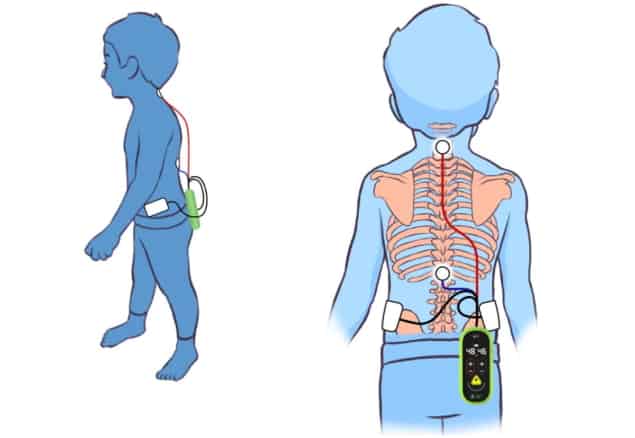Non-invasive neuromodulation improves motor function in children with cerebral palsy
09 Nov 2022 Natalie Rhodes
Non-invasive therapy: The set-up of the SCiP device, demonstrating the placement of the non-invasive electrodes over the cervical and thoracic regions of the spinal cord. (Courtesy: CC BY 4.0/Nat. Commun. 10.1038/s41467-022-33208-w)
Cerebral palsy (CP), a lifelong condition that impairs sensory and motor function, is the most common motor disability in childhood, affecting about one in 345 children in the US. The standard-of-care treatment for CP often includes activity-based neurorehabilitation therapy, orthopaedic exercises to strengthen groups of muscles and general exercise to sustain motor function through development. However, these treatments only address the symptoms of CP, aiming to decrease traits such as involuntary muscle contractions. There are currently no methods available to address the underlying causes of the condition.
SpineX, a medtech company based in California, has developed a non-invasive device that delivers spinal neuromodulation during neurorehabilitation therapy. The aim is to improve clinical outcomes for children undergoing therapy for CP. A research team, led by Susan Hastings and V Reggie Edgerton, has now used the device to treat a group of children with CP, publishing the results in Nature Communications.
The SCiP (spinal cord innovation in paediatrics) device applies simultaneous electrical stimulation via two non-invasive electrodes attached to the patient’s back. This stimulation involves the application of two alternating pulses of high frequency (10 kHz) followed by low frequency (30 Hz).
Such stimulation is known to affect spinal cord electrical activity and has been used to treat chronic back and lower-limb pain since the late 1960s. However, the team notes that SCiP is the world’s first non-invasive spinal neuromodulation device, as it applies stimulation through the skin, rather than requiring implants.
For the study, the researchers recruited 16 children with CP diagnoses (aged from two to 18). Each child attended two hour-long neurorehabilitation therapy sessions per week for eight weeks, during which they performed a series of activities. These included treadmill walking, standing up from seated, lateral and backwards stepping, and climbing. During this routine, the SCiP device applied stimulation. Importantly, none of the children reported any pain or discomfort during the neuromodulation. Spinal neuromodulation: The SCiP device aims to treat the underlying neurological dysfunction related to CP. (Courtesy: Parag Gad)
Spinal neuromodulation: The SCiP device aims to treat the underlying neurological dysfunction related to CP. (Courtesy: Parag Gad)
 Spinal neuromodulation: The SCiP device aims to treat the underlying neurological dysfunction related to CP. (Courtesy: Parag Gad)
Spinal neuromodulation: The SCiP device aims to treat the underlying neurological dysfunction related to CP. (Courtesy: Parag Gad)Notably, the study concluded that all 16 children demonstrated clinically significant improvements in their gross motor function measure (GMFM) scores – the gold standard metric for measuring voluntary sensory and motor functions. Crucially, while nine children started the study needing maximum assistance to walk, by the end, only four still required full assistance. Overall, the device–therapy combination led to an improvement in quality-of-life for all 16 of the children.
Parag Gad, co-founder and chief executive of SpineX, and his colleagues are excited to take this device to the next stage. They are now working to set up a clinical trial, proposed to begin in 2023, with the aim of achieving clearance from the US Food and Drug Administration to use the SCiP as a treatment tool for CP.

Natalie Rhodes is a PhD student contributor to Physics World. Natalie is studying medical physics at the University of Nottingham. Find out more about our student contributor networks
from physicsworld.com 15/11/2022

Δεν υπάρχουν σχόλια:
Δημοσίευση σχολίου